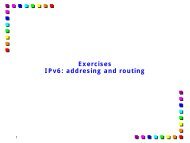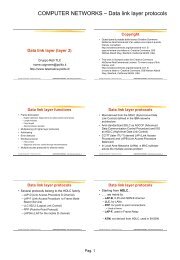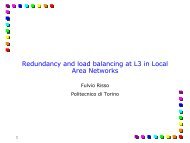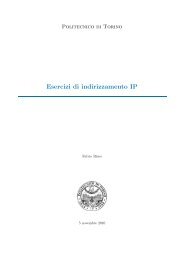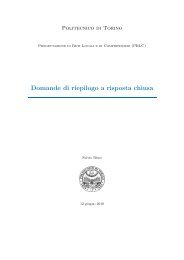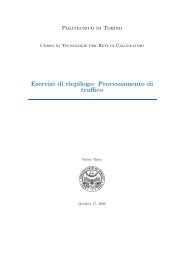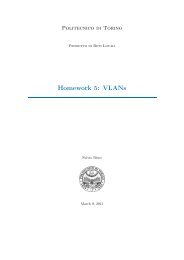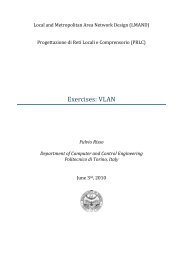High-Speed Policy-based Packet Forwarding Using Efficient Multi ...
High-Speed Policy-based Packet Forwarding Using Efficient Multi ...
High-Speed Policy-based Packet Forwarding Using Efficient Multi ...
Create successful ePaper yourself
Turn your PDF publications into a flip-book with our unique Google optimized e-Paper software.
Figure 1: Queueing model of a system that uses a cache-<strong>based</strong> architecture for packet classification.<br />
times, it must operate at wire-speed when all packets<br />
are as small as 44 bytes. This means that the algorithm<br />
must have provably small worst-case execution<br />
times which are independent of traffic patterns.<br />
3. Classification rules must be <strong>based</strong> on several fields of<br />
the packet header, including among others source and<br />
destination IP addresses, source and destination port<br />
numbers, protocol type and Type-of-Service. The rules<br />
must be able to specify ranges and not just exact values<br />
or simple prefixes<br />
4. For some applications, it might be possible to limit<br />
the requirements to only two dimensions and to have<br />
ranges defined only as prefixes. This is a more restricted<br />
problem than the general classification problem<br />
but it has a very useful application in both multicast<br />
lookups and in RSVP reservations that use either<br />
wild-card filters or CIDR aggregations [15, 281.<br />
5. It is possible that some packets may match more than<br />
one rule. The algorithm must allow arbitrary priorities<br />
to be imposed on these rules, so that only one of these<br />
rules will finally be applicable to the packet.<br />
6. Updates of rules are rare compared to searches in the<br />
data structures. In particular, the frequency of updates<br />
is in the time-scale of tens of seconds or longer<br />
whereas look-ups happen for every processed packet.<br />
At a packet processing rate of lo6 packets per second,<br />
the ratio of look-ups to updates is 107. Hence, the algorithms<br />
can be optimized for lookups even if it means<br />
degrading update performance to some extent.<br />
7. Memory accesses are expensive and are the dominant<br />
factor in determining the worst-case execution time.<br />
8. Memory is organized in words of size w and the cost<br />
of accessing a word is the same as the cost of accessing<br />
any subset of bits in a word.<br />
9. Memory cost can be relatively low if technologies such<br />
as Synchronous Dynamic RAMS (SDRAMs) are used.<br />
These devices can provide very large capacity com-<br />
bined with a high access speed, provided that accesses<br />
are sequential. A packet classifier implementation that<br />
requires multiple sequential accesses in a high-speed<br />
SDRAM memory might be more affordable than an<br />
algorithm of lower time-complexity that uses highercost,<br />
lower capacity memories like SRAMs.<br />
10. For operation at very high speed the algorithm must be<br />
amenable to hardware implementation. While we do<br />
not preclude software implementations of our proposed<br />
algorithms, we are primarily interested in algorithms<br />
that are implementable in hardware as well and are<br />
not restricted to only a software implementation.<br />
3 Previous Work<br />
The idea for packet filtering, or classification in general, was<br />
initiated in [16] and was later expanded in [19, 271. The<br />
architectures and algorithms presented in these papers were<br />
targeted mainly for an end-point and their main goal was<br />
to isolate packets that are destined to specific protocols or<br />
to specific connections. The algorithms used, although they<br />
involved a linear parsing of all the filters, were fast enough<br />
to operate at end-point link capacities. Obviously these implementations<br />
do not scale to very high speeds.<br />
An interesting variation was presented in [l] where the<br />
first hardware implementation of packet filters was reported.<br />
The implementation, although fast enough to support an<br />
OC-12 link, is restricted to only a small number of rules<br />
(< 12) and is not general enough for a commercial highspeed<br />
router. The implementation uses a pipelined architecture,<br />
resulting in O(1) performance using O(N) processing<br />
elements for O(N) rules. Clearly, such an algorithm cannot<br />
scale to a large number of filter rules since it requires a linear<br />
number of processing elements. Moreover, this scheme was<br />
designed for rules that required exact matching and not for<br />
rules defined as ranges.<br />
The general packet classification problem that we consider<br />
can be viewed as a point location problem in multidimensional<br />
space. This is a classic problem in Computational<br />
Geometry and numerous results have been reported in the<br />
literature [5, 6, 111. The point-location problem is defined<br />
as follows: Given a point in a d-dimensional space, and a<br />
set of n d-dimensional objects, find the object that the point<br />
belongs to. Most algorithms reported in the literature deal<br />
with the case of non-overlapping objects or specific arrangements<br />
of hyperplanes or hypersurfaces of bounded degree<br />
1221. When considering the general case of d > 3 dimensions,<br />
as is the problem of packet classification, the best algorithms<br />
considering time or space have either an O(logd-’ n)<br />
complexity with O(n) space, or an O(log n) time-complexity<br />
with O(nd) space. [22]. Though algorithms with these complexity<br />
bounds are useful in many applications, they are<br />
mostly not directly useful for packet filtering. For packet



